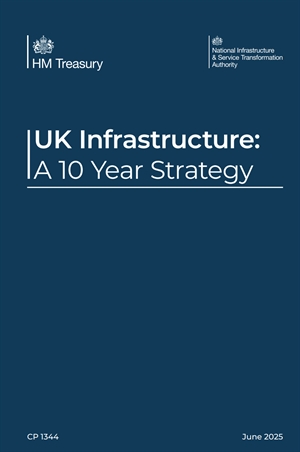UK Infrastructure Strategy addresses 'critical' sectors including transport and energy
Thu 19 June 2025
View all news

The Government's new Infrastructure Strategy aims to “provide the certainty and stability needed to attract investment, boosting British supply chains and jobs, and takes a joined-up view to improve planning and delivery across all types of infrastructure”.
Decarbonising transport and producing clean energy are central to the Government’s plans.
A key pillar of the strategy is the decarbonisation of energy networks through grid reforms and by prioritising the delivery of renewable power under the Clean Power 2030 pathway. Electrification will be the primary route to decarbonisation, with electricity demand expected to at least double by 2050. According to the strategy, this will only happen with massive infrastructure investment, both in energy generation and building out electricity networks. It will also require innovation to bring, for example, new long duration storage into the electricity system and investing in new generation assets like small modular reactors (SMRs).
Central to the strategy is the establishment of Great British Energy (GBE), a state-owned enterprise backed by around £8 billion of public funding in its initial period to invest in offshore wind, hydrogen, carbon capture, and nuclear projects.
The Government says that meeting the ambitious goals of clean power and net zero requires different ways of planning and managing the energy system; to help deliver this, the Department for Energy Security and Net Zero has created the Clean Power 2030 Unit and established the new independent National Energy System Operator (NESO).
The strategy says that road vehicle mileage is forecast to rise by approximately 10% by 2035. Against this backdrop, it outlines how £2.6bn capital investment will be provided from 2026-27 to 2029-30 to support the rollout of electric vehicles and associated charging infrastructure, as well as encouraging innovation in hard to abate sectors like maritime and aviation.
The plans include the allocation of £1.4 billion to the Office for Zero Emission Vehicles (OZEV) to fund projects supporting the transition to zero emission vehicles, and £400 million to support further rollout of charging infrastructure.
For HGVs, the Government is providing up to £200 million by March 2026, as part of the Zero Emission HGV and Infrastructure (ZEHID) programme. Over five years, the programme will build evidence to guide future investment in zero emission HGV technologies, with 54 initial infrastructure sites announced.
Active travel, such as walking and cycling, is mentioned in the strategy as playing a 'vital role' in reducing transport-related carbon emissions, improving air quality, reducing congestion and promoting healthier communities. The Government has committed to invest £616 million for Active Travel between 2026-27 and 2029-30 to support greater use of these modes.
On energy, the Government said it would work with Ofgem and NESO to reform the connections process. This will ensure that the right projects can connect to the grid when they are needed, with priority given to projects that align with the Clean Power 2030 target.
Underpinning both transport and energy ambitions, the strategy introduces institutional and delivery reforms through NISTA (National Infrastructure and Service Transformation Authority) to ensure timely, coordinated project execution. The strategy also aims to strengthen grid connection processes, streamline planning, and boost public-private collaboration via mechanisms like the National Wealth Fund.
This approach aims to provide long-term, stable funding, drive decarbonisation, and stimulate private-sector involvement—creating a coordinated and future-ready infrastructure base supporting both green transport and clean energy goals.
Commenting on the strategy, Chancellor of the Exchequer, Rachel Reeves said: “Infrastructure is crucial to unlocking growth across the country, but for too long investment has been squeezed. Crumbling public buildings are a sign of the decay that has seeped into our everyday lives because of a total failure to plan and invest.
“We’re not just fixing buildings – we’re enhancing public services, improving lives and creating the conditions for sustainable economic growth in communities throughout the UK."
Related Links
< Back to news list